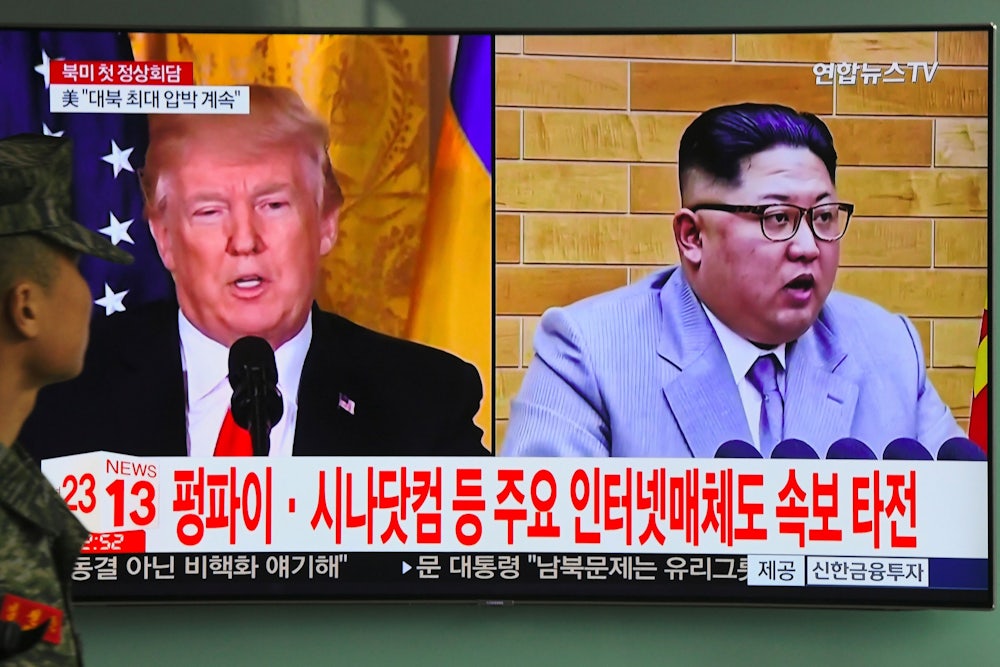Six months ago, Donald Trump and Kim Jong Un were trying to outdo each other by comparing the size of their nuclear buttons. How times have changed. The announcement earlier this week that CIA Director Mike Pompeo had met with Kim Jong Un, and confirmed that North Korean denuclearization was on the table, was a massive development. This was followed Friday by a North Korean announcement that it would be abstain from nuclear weapons and missile tests and would be shutting down its nuclear test site at Punggye. Momentum for the announced Trump-Kim summit is building, as are the expectations that a real breakthrough is possible. It is almost as if a peace race has broken out.
Everyone watching would do well to take a deep breath. Yes, it is possible that Kim Jong Un has decided that he has had enough of pressure and threats and isolation and the future of his country lies not in being a nuclear state, but in economic development and normalization. We know little about Kim’s actions and even less about his thinking. So no one can or should rule this out completely. Yet there may be a more obvious and logical explanation for what we are seeing.
Kim launched his recent charm offensive after a series of unprecedented, strident, and inflammatory statements by President Trump. The prospect of fire and fury, destruction like the world had never seen, and armadas streaming toward North Korea all set the world on edge. There was serious and widespread concern that the nuclear and missile tests by the North, and Trump’s disruptive style of response, could lead to an unintended or accidental war or even to a nuclear exchange. Reports that the Trump administration was seriously considering a “bloody nose” conventional strike to warn Kim off of any planned aggression were rampant in Washington. When Victor Cha, widely rumored to be the Trump administration’s pick for U.S. ambassador to South Korea, came out against such a strike publicly, he was reportedly dropped from consideration. South Korean officials and public began to worry more about the United States launching an attack than about Pyongyang, a remarkable sea change in opinion.
Thus began Kim’s seduction of the South. Kim agreed to a joint Democratic People’s Republic of Korea-Republic of Korea team for the Pyeongchang Olympics, and then sent his sister and the DPRK Cheer Team to attend the opening ceremonies. Since then, Kim has played the more reasonable negotiating partner, stating that he wanted to meet with Trump (who accepted), that he would not object to U.S. military exercises (that were then scaled down), and now that he would not only suspend nuclear and missile tests but would shutter his nuclear test site. All of these steps walk back from the brinksmanship that has marked Kim’s approach since he assumed power with the death of his father, and contrast him with the U.S. approach to date. Trump and his administration have bragged that they have given up nothing to get to the table with Kim (not surprising, since North Korea has wanted direct high-level talks with the United States for decades) and that the maximum pressure campaign would continue until North Korea took real irreversible steps to eliminate their strategic WMD programs.
Maybe this is unintentional, but the dynamics almost make it seem that the DPRK is willing to do more and take more risks in the pursuit of peace and reconciliation than the United States. As such, it puts the U.S. in a very disadvantageous position should the summit fail to achieve a dramatic breakthrough, as most analysts believe. Negotiating full elimination of North Korea’s nuclear and missile capabilities under effective verification will take months, and implementation years. So, if the U.S refuses an extended diplomatic process, as seems likely given Trump and National Security Advisor John Bolton’s past statements, then the DPRK will be in a good position to paint the United States as the unreasonable party.
While that may not sell in the United States—where even if President Trump is mired at 40 percent approval ratings he still presumably outpolls Kim Jong Un in trustworthiness (I’m not aware of a poll that has actually checked, but it is a reasonable guess)—it will sell in South Korea and cast the U.S. as again the aggressor who is putting the South at risk.
This vulnerability of the American image in South Korea is a remarkable turn of events, and one that the United States needs to take more seriously. The mismanagement of the U.S.-ROK alliance, as evidenced by Trump’s move on trade tariffs and to try and charge South Korea for the deployment of missile defenses and bomber flyovers, has cost the U.S. much of its popularity and public support in South Korea. North Korea may be trying to exploit this opening—both with its charm offensive, and with its rolling announcements that cast it in a better and more positive light than the one cast on the United States and Donald Trump. The Kim dynasty has long sought to undermine the U.S.-ROK alliance and put itself in a better position to dictate terms of cooperation and even subjugation to the South. This may be just an updated play from the historical playbook.
We should all support Donald Trump’s decision to pursue negotiations and abandon threats and bluster. The region is benefitting from the stability that chance has enabled. But while hoping the summit will bring success, a bit of defense is in order as well. Not being blamed for the summit’s possible failure is part of ensuring the summit is a success for our security, regardless of whether DPRK moves are sincere or cynical.
